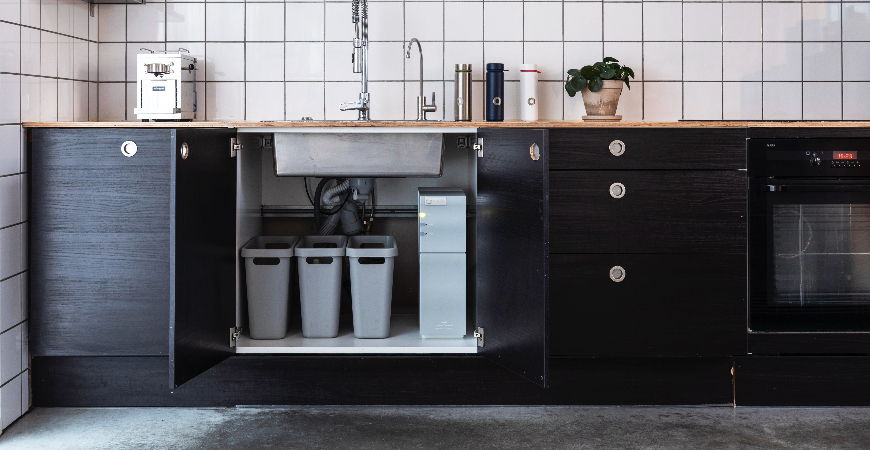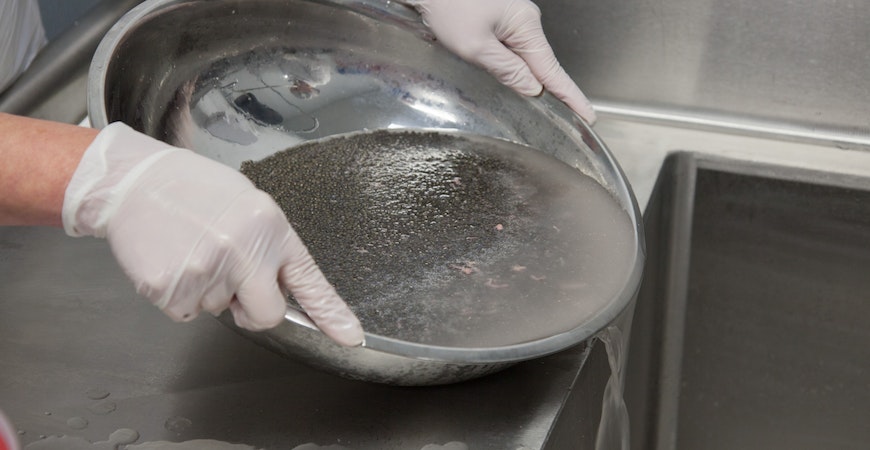
Make Your Kitchen Sink Cleaner With a Fall Check Up
Our kitchen sinks take a lot of abuse. Yet, we often forgo the steps that make our kitchen sink cleaner until its dirtiness becomes an issue.
Because fall is a time for cooking, now’s the time to give your sink, drain, and garbage disposal their yearly checkup and cleaning. A clean kitchen sink, drain, and garbage disposal are some of the best ways to prevent big holiday dinners from transforming into a disaster.
Cleaning Your Garbage Disposal
In theory, garbage disposals are a major kitchen convenience. You can drop tiny food scraps down the drain, flick the switch, and wash your refuse away forever.
In practice, though, garbage disposals can suffer any number of issues. Even if you have one that’s working properly, you may eventually whiff the lingering stench of trapped, decomposing food bits.
Fortunately, cleaning your garbage disposal is a straightforward process. As long as you follow critical safety steps, you should be able to rid yourself of that gnarly odor.
To clean your disposal , follow these steps:
Turn off the power to your disposal by unplugging it. Do not go further in these steps until you have confirmed the garbage disposal has no power.
Use a flashlight to see if you can see anything stuck or lodged in the disposal blades, such as vegetable fibers, bottle caps, or shards of meat bones.
If you see anything stuck, use pliers or tongs to remove them. Always treat the disposal as if it’s on, so never stick your hands into it.
Once you’ve removed any debris, drop a dozen ice cubes into the disposal chute along with a half cup of rock salt.
Plug in the disposal and let it run for a minute. Then, re-check the drain with your flashlight to see if the blades are clean and nothing is stuck.
Unplug the disposal again.
Pour in a cup of vinegar, then a half-cup of baking soda. Do not use a chemical-based kitchen sink drain cleaner.
Let the homemade garbage disposal cleaning solution bubble and fizz for 15 minutes.
In a small mixing bowl, combine a cup of vinegar and half-cup of baking soda to form a thick paste. Using an old toothbrush, use the paste to scrub the tops and bottoms of the rubber flaps at the top of the disposal drain.
If you notice any bacterial build-up elsewhere near or inside the disposal, scrub it using the paste and toothbrush. Again, do not put your hand inside the device at any time.
When things seem adequately scrubbed and cleaned, plug in the garbage disposal and plug the drain. Fill the sink about three-fourths full.
Add a teaspoon of dish soap to the water. Then, pull the drain plug and turn on the disposal until the sink fully drains through the disposal.
Ideally, you should clean your garbage disposal every two weeks. You don’t need to go through this entire cleaning cycle, though.
Instead, choose the ice and rock salt mixture or the vinegar and baking soda method. To keep things smelling fresh, consider throwing some citrus peels down the disposal while you run it every week or so.
Washing Your Kitchen Sink and Drain
We expect a lot out of our kitchen sink. We dump unneeded, dirty liquids down it and then use the basin to defrost meat and wash our produce.

That may be why the kitchen sink is often one of the dirtiest places in your home. Even worse, the tools we use to clean it — like sponges — are often just as bacteria-packed, if not more so.
So, you may be using your kitchen sink to wash your hands, clean your produce, and engage in other sanitary practices, but in reality, you could be making yourself sick. That’s not great.
While you may be tempted to pull out a bottle of bleach to decimate the bacterial population, you could damage your sink’s surfaces. Bleach splashback could also end up on counters, drying racks, or other areas that come in direct contact with food.
When cleaning your sink, it’s best to skip over harsh solvents. Instead, use Wet & Forget Indoor.
Wet & Forget Indoor is an all-in-one cleaner, disinfectant, deodorizer, and sanitizer. When used on hard, non-porous surfaces, it kills 99.9% of bacteria and viruses.*
It also attacks odors at the source, inhibits the growth of mold and mildew, and cuts through grease and grime. So, if your sink is dirty, smelly, or looking gross, it’s the ultimate kitchen sink cleaner.
Using it couldn’t be easier.
To sanitize and deodorize, apply the kitchen sink cleaner to the relevant surface. Allow surfaces to remain visibly wet for 10 minutes.
At that point, you can continue to let the surface air dry. Repeat weekly to inhibit mold and mildew growth.
To cut through grease and grime, spray Wet & Forget Indoor on the needed surface. Then wipe dry.
*As a disinfectant, Wet & Forget® Indoor Mold+ Mildew Disinfectant Cleaner kills: Pseudomonas aeruginosa, Salmonella enterica, Serratia marcescens, *Human Coronavirus,*lnfluenza Virus Type A/ Hong Kong, *SARS Associated Coronavirus cause of Severe Acute Respiratory Syndrome, *SARS-Related Coronavirus 2 SARS-CoV-2 cause of COVID-19, *Vaccinia (Pox Virus), *Norwalk Virus (Norovirus), *Rotavirus.”
Knowing What Should Go Down Your Kitchen Drain
Of course, the goal is to prevent you from going all out cleaning your kitchen sink, drain, and garbage disposal. One of the best prevention techniques is knowing what should and should not go down your kitchen sink.
So, here’s a quick rundown of what should never be poured down your drain or run through the garbage disposal:
- Bleach or commercial cleaners. They can damage surfaces and lead to contamination of nearby surfaces.
- Bones. Bones are too hard to break up, and if they splinter, they can become dangerous.
- Fibrous or starch leftovers, like potato peels or pasta. They can gum up the blades and cause clogs.
- Glass. If you place glass in your disposal, it can shoot broken-up shards back up at you.
- Oil or grease. Instead, let the grease or oil cool, seal it in a can or jar, and throw it out with your garbage.
- Seafood shells. Shells are also too hard to break up and can cause a clog.
A quick note about grease. It’s tempting to dump grease into your sink drain, but you should never do it.
Even though your leftover cooking grease may be liquid now, it will become solid when it cools. When that occurs, it can cause severe clogs deep within your plumbing.
If you keep doing it, you could result in sewage backing up through every drain in your home: sinks, bathtubs, and toilets. Perhaps even more disgusting than the resulting mess is the hefty repair bill.
When You Should Call a Plumber
Many issues with your home sink and garbage disposal can be resolved using the tips above. With the right tools, even clogs can be fixed without needing professional help.
But sometimes, calling a plumber to scope out the problem and fix it will save you time, frustration, and — in the long run — money, too.
So, if you’re dealing with any of these issues, don’t hesitate to reach out to a plumber:
- Brown spots on the floor beneath your sink or on the ceiling of the room under your kitchen.
- Clogs that aren’t fixed after trying home remedies and tools.
- Extremely low water pressure.
- Rattling pipes beneath your sink.
- Smells that don’t dissipate after trying the steps listed above.
Keeping Your Kitchen Sink, Drain, and Garbage Disposal Clean
Fall is a time for family gatherings centered around a well-tended meal. Of course, if your kitchen sink is packed with bacteria, giving off weird odors, and backing up with sewage, that family get-together will quickly become a family split-up.
So, take the time to clean your kitchen sink, drain, and garbage disposal before the festivities arrive. With our straightforward tips above, you have everything you need for a healthy, clean, and odor-free kitchen.










